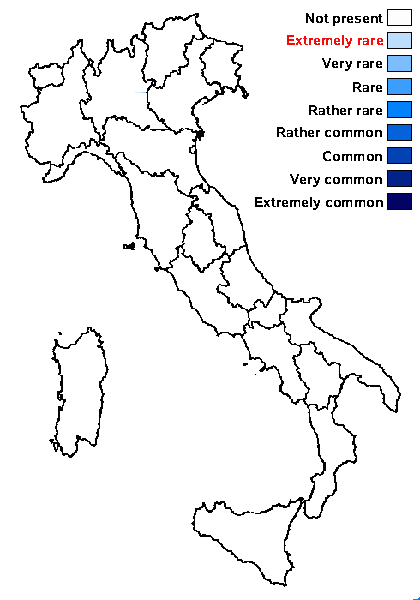Buellia uberiuscula (Nyl.) Zahlbr.
Cat. Lich. Univ., 7: 426, 1931. Basionym: Lecidea uberiuscula Nyl. - Bull. Soc. linn. Normandie, sér. 2, 6, 2: 279, 1872
Synonyms:
Distribution:
Description: Thallus crustose/subsquamulose, episubstratic, consisting of a few, grey to yellowish white, matt, epruinose areoles/squamules developing on the thalli of Sporastatia- or of brown Acarospora-species. Medulla white, I+ blue. Apothecia cryptolecanorine to zeorine, 0.3-0.4 mm across, immersed in the center of areoles, angular to irregularly circular, with a black, epruinose, flat disc and a usually indistinct proper margin that is sometimes surrounded by a thalline collar. Proper exciple poorly differentiated, Aethalea-type, the inner hyphae narrow, hyaline, prosoplectenchymatous, the outer hyphae parallel, moderately swollen and usually strongly carbonized with brown and aeruginose pigments reacting N+ violet-red; epithecium brown to olive, N+ violet-red; hymenium colourless, not inspersed with oil droplets; paraphyses simple to moderately branched in upper part, apically swollen, with a brown pigment cap; hypothecium colourless. Asci 8-spored, clavate to cylindrical-clavate, the apical dome K/I+ dark blue with a pale, conical-pointed apical cushion (axial mass), the wall I-, but the thin outer gel I+ blue, Bacidia-type. Ascospores 1-septate, brown, broadly oblong-ellipsoid with obtuse ends, 12.5-15 x 7-9 µm, Buellia-type, thin-walled throughout, the wall microrugulate. Photobiont chlorococcoid. Spot tests: K+ red (needle-like crystals), C-, KC-, P+ yellow, UV-. Chemistry: norstictic and connorstictic acids. Note: on nutrient-rich surfaces of siliceous rocks, lichenicolous on other crustose lichens (e.g., Acarospora fuscata, Sporastatia testudinea), with a few records from the Austrian Alps; to be looked for in the Italian Alps.
Growth form: Crustose
Substrata: rocks
Photobiont: green algae other than Trentepohlia
Reproductive strategy: mainly sexual
paras Acarospora fuscata and Sporastatia testudinea

Predictive model
Growth form: Crustose
Substrata: rocks
Photobiont: green algae other than Trentepohlia
Reproductive strategy: mainly sexual
paras Acarospora fuscata and Sporastatia testudinea

Predictive model
 INDEX FUNGORUM
INDEX FUNGORUM
 GBIF
GBIF

